Daily News
by Gail Helmer
[ Send Us News | Archives ]
Ubi Soft has launched the official IL-2 Sturmovik website. From now on the new site will provide the latest news, downloads, updates and features from IL-2 Sturmovik. Although currently short on information, this new site includes a brief interview with the Oleg Maddox, exclusive screenshots and a 3D cockpit. Ubi Soft has also announced that a demo of IL-2 Sturmovik will be released soon. Release Date: November 2001.
Allied Assault Movie 3 Released
Electronic Arts has released movie 3 of 4 for the Normandy Campaign (Mission 3 Level 1)from the upcoming title "Medal of Honor: Allied Assault". This weeks continuing saga shows Lieutenant Mike Powell using bangalores to clear the barbwire in order for his team to make it up to the concrete gun emplacements.
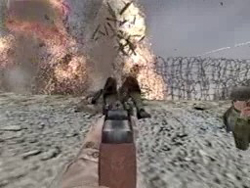
Allied Assault includes 22 different types of enemies, 18 enemy vehicles, and 21 weapons to take them out--including Thompson submachine guns, Mark II Frag grenades, flame throwers, sticky bombs, and a .50 caliber mounted machine gun. An assortment of interactive vehicles like M4 Sherman Tank, are also available. As far as multiplayer in concerned, Allied Assault will feature team combat and deathmatch modes. Release Date: October 2001. Click here to check it out.
New Commandos 2 Screens
Eidos has released new screenshots from their squad-based tactical shooter, Commandos 2. The new "Commandos 2: Men of Courage" screenshots show some interiors as well as the beautifully detailed environments. Rumors are swirling on whether this title is complete or not, and Eidos is keeping the details to themselves. Release Date: Fall 2001
Win A Geforce3-Based Gaming System
NVIDIA has announced a contest to win a gaming computer from Monarch Computer Systems. Equipped with an MSI graphics cards, featuring the NVIDIA GeForce3 GPU and its nFiniteFX Engine. Register between August 1 and August 31, 2001 for your chance to win. Click here to enter.
The Boeing and Lockheed Martin teams competing for the lucrative Joint Strike Fighter contract have simultaneously announced the successful completion of their flight testing programmes. The US defence department is due to reveal the winner of the contract for the new jet, which will have the capability for short take-offs and supersonic flight, in late October. With the JSF, the intended replacement for the US's ageing F-16 and F-18 fleets, also being eyed by the British Ministry of Defence, the contract could be worth upwards of $200 billion.
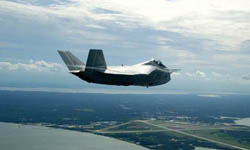
Boeing JSF X32-B
Both sides are confident that their aircraft will win the day and the respective publicity departments will now attempt to convince shareholders and the rest of the world of this. For Boeing this means an industrial battle on two fronts, with the company's ongoing struggle with Airbus for control of the commercial skies.
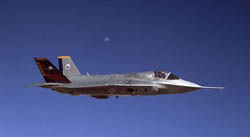
Lockheed Martin JSF X35-B
Lockheed Martin fanfared the successful completion of its X-35B programme with the revelation that its aircraft has become the first aircraft to complete a short takeoff, a level supersonic dash and a vertical landing in a single flight. "The best reward for this team's hard work over the years is a great success story like this. It was a privilege to be a small part of this history-making event," said test pilot Major Tomassetti.
Meanwhile, Boeing championed its X-32B demonstrator craft for completing five successive successful flights on July 28th. "During the build-down from conventional flight to hover and vertical landing, we flew 30 flights in eight days. And now, on the last day of flight test, we flew five times in one day. That's just amazing," said Dennis O'Donoghue, Boeing chief STOVL test pilot.
Both Boeing and Lockheed Martin are extolling the virtues of their management teams and the extent to which they have fulfilled the US Government's requirements for the JSF programme and are now confidently predicting efficient progress towards the next phase. "This completes the third and final phase of a concept demonstration programme that has redefined the standard for flight test. The Lockheed Martin JSF team made a promise and kept it - including fielding a demonstrator aircraft that is representative of the one we have planned for production," said Tom Burbage, executive vice president and general manager of the Lockheed Martin JSF program. "That means fewer expensive development hurdles to clear and a more seamless transition into the program's next phase, Engineering and Manufacturing Development."
"Few, if any, flight-test programmes have been more successful than the X-32," said Jerry Daniels, president and chief executive officer of Boeing Military Aircraft and Missile Systems. "It is a testament to the dedicated people on the Boeing JSF One Team that the X-32's demonstrated performance so precisely matched predictions."
"The X-32B test programme was a resounding success thanks in part to our innovative use of modelling and simulation as well as the outstanding efforts of the Boeing One Team," said Frank Statkus, Boeing vice president and JSF general manager. "The government has made it clear that it's buying not only an airplane but also a management team. Our performance during this test programme says everything about our team."
However, it is worth noting that although the current plan is to name one winner, a prime contractor could be announced with the losing contender receiving a share of the actual production. This would lessen the impact of any financial repercussions for the unsuccessful bidder and utilise the expertise of both teams. Precedent has been set with the development of the F-22, for which Lockheed Martin won the contract in 1991, but in which Boeing is playing a major role.
For more on the JSF program, check out the: Boeing JSF Video and Lockheed Martin JSF Video.
Air Force Releases F-16 Accident Report
Air Force investigators have determined foreign object damage caused the engine failure that resulted in the April 3 crash of an F-16 Fighting Falcon aircraft into the ocean off the coast of Japan. The pilot ejected from the aircraft with minor injuries.
The incident occurred at 4:21 p.m. about 10 miles northeast of Misawa Air Base, Japan, on Ripsaw Range.
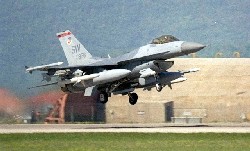
While flying a mission qualification training sortie, the pilot reported an engine problem as the aircraft flew over the range. He immediately turned the aircraft toward Misawa and attempted to "air start" the engine without success. About 70 seconds after reporting the engine problem, the pilot successfully ejected and parachuted into the Pacific Ocean.
The aircraft hit the water about 500 meters off shore and was destroyed.
Based on evidence obtained during the investigation, the Accident Investigation Board found there were three causes of the mishap: Foreign object damage to compressor blade No. 30; the subsequent failure of blade No. 30; and a subsequent titanium fire and burn-through of the compressor case caused by the lodging of the failed blade within the compressor case.
Once the engine case was breached, air pressure to the engine was lost and the engine could not produce thrust or be restarted.
Because the engine failure occurred at low altitude and there was no useable runway close enough to land, the pilot's decision to eject was correct, officials said.
Italy's New Aircraft Carrier Under Construction
Fincantieri has cut the first metal for the construction of Italy's new aircraft carrier and flagship, which will be called the Andrea Doria. Work is being carried out in the company's yards at Riva Trigoso (Genoa) and Muggiano (La Spezia) and the ship will be delivered in 2007.
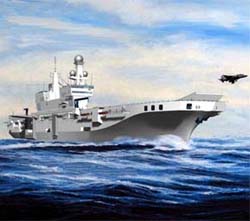
The ship will have a standard displacement of about 22,000 tonnes, an overall length of about 235 metres and a speed of no less than 29 knots; it will be able to accommodate up to 1,290 people on board comprising a maximum landing force of 450.
The ship has been designed to be both an aircraft carrier and an amphibius landing ship, with the capacity to embark a battalion sized assault force. The vessel will be equipped with a flight deck suitable both for operations with helicopters and with STOVL aircraft and a hangar/garage of approximately 2,500 square metres. Two elevators will be installed for aircraft and there will be two access ramps to move vehicles from the quayside to the hangar/garage.
The ship will be a hospital facility with three operating rooms, wards for hospitalised patients, X ray and CT equipment, a dentist's surgery and a laboratory.
JASSM Completes Fourth Development Flight Test
The US Joint Air-to-Surface Standoff Missile (JASSM) completed its fourth development flight test (DT-4) at the White Sands Missile Range in New Mexico on Friday. DT-4 was designed to demonstrate JASSM compatibility with the B-52 and system performance.
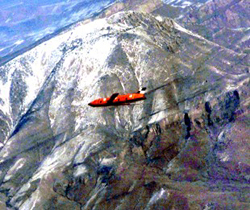
In the test, the missile was launched from a US Air Force B-52H at an altitude of 24,000 feet mean sea level above the New Mexico desert at Mach 0.85. After weapon release, the vehicle separated cleanly and flew for 18 minutes, navigating through 8 waypoints and travelling approximately 158 miles. The missile used the seeker imagery to successfully guide itself to the target, although warhead did not detonate because the fuse made itself safe itself when communications were interrupted.
"...The impact was right on target. We are now analysing the flight data to determine the cause of the communications anomaly," stated Mike Inderhees, Lockheed Martin JASSM Programme Manager. The fuse is being recovered to determine exactly why communication was incomplete. "We believe we can confirm our initial findings upon recovery of the fuse and do not expect any impact to the production schedule. We are confident that any changes will be made before our next flight test," Inderhees added.
"A key to our success has been our ability to correct these types of discoveries and demonstrate them in subsequent flights," said Colonel Tim Moore, JASSM Programme Manager, Joint Programme Office.
Before Friday's flight, JASSM had successfully completed 25 flights: 6 powered, 6 unpowered and 13 jettisons.
One of the Department of Defense's highest priority programmes, JASSM is designed to give Air Force and Navy pilots long-range standoff capability against a wide array of high value, heavily defended targets. Its anti-jam GPS satellite navigation system, state-of-the-art infrared seeker, 1,000-pound penetrator warhead and stealth airframe makes it extremely difficult to defend against. The 2,250 pound 14-ft. long missile is designed to be launched from the B-2, B-52H, B-1B, F-16C/D and F/A-18 E/F aircraft.
[ Send Us News | Archives ]
by Gail Helmer
Thursday August 2, 2001
- Official IL-2 Sturmovik Website Launched
- Allied Assault Movie 3 Released
- New Commandos 2 Screens
- Win A Geforce3-Based Gaming System
- Boeing, Lockheed Martin Complete JSF Testing
- Air Force Releases F-16 Accident Report
- Italy's New Aircraft Carrier Under Construction
- JASSM Completes Fourth Development Flight Test
PC News
Official IL-2 Sturmovik Website LaunchedUbi Soft has launched the official IL-2 Sturmovik website. From now on the new site will provide the latest news, downloads, updates and features from IL-2 Sturmovik. Although currently short on information, this new site includes a brief interview with the Oleg Maddox, exclusive screenshots and a 3D cockpit. Ubi Soft has also announced that a demo of IL-2 Sturmovik will be released soon. Release Date: November 2001.
Allied Assault Movie 3 Released
Electronic Arts has released movie 3 of 4 for the Normandy Campaign (Mission 3 Level 1)from the upcoming title "Medal of Honor: Allied Assault". This weeks continuing saga shows Lieutenant Mike Powell using bangalores to clear the barbwire in order for his team to make it up to the concrete gun emplacements.

Allied Assault includes 22 different types of enemies, 18 enemy vehicles, and 21 weapons to take them out--including Thompson submachine guns, Mark II Frag grenades, flame throwers, sticky bombs, and a .50 caliber mounted machine gun. An assortment of interactive vehicles like M4 Sherman Tank, are also available. As far as multiplayer in concerned, Allied Assault will feature team combat and deathmatch modes. Release Date: October 2001. Click here to check it out.
New Commandos 2 Screens
Eidos has released new screenshots from their squad-based tactical shooter, Commandos 2. The new "Commandos 2: Men of Courage" screenshots show some interiors as well as the beautifully detailed environments. Rumors are swirling on whether this title is complete or not, and Eidos is keeping the details to themselves. Release Date: Fall 2001
Win A Geforce3-Based Gaming System
NVIDIA has announced a contest to win a gaming computer from Monarch Computer Systems. Equipped with an MSI graphics cards, featuring the NVIDIA GeForce3 GPU and its nFiniteFX Engine. Register between August 1 and August 31, 2001 for your chance to win. Click here to enter.
Military News
Boeing, Lockheed Martin Complete JSF TestingThe Boeing and Lockheed Martin teams competing for the lucrative Joint Strike Fighter contract have simultaneously announced the successful completion of their flight testing programmes. The US defence department is due to reveal the winner of the contract for the new jet, which will have the capability for short take-offs and supersonic flight, in late October. With the JSF, the intended replacement for the US's ageing F-16 and F-18 fleets, also being eyed by the British Ministry of Defence, the contract could be worth upwards of $200 billion.

Both sides are confident that their aircraft will win the day and the respective publicity departments will now attempt to convince shareholders and the rest of the world of this. For Boeing this means an industrial battle on two fronts, with the company's ongoing struggle with Airbus for control of the commercial skies.

Lockheed Martin fanfared the successful completion of its X-35B programme with the revelation that its aircraft has become the first aircraft to complete a short takeoff, a level supersonic dash and a vertical landing in a single flight. "The best reward for this team's hard work over the years is a great success story like this. It was a privilege to be a small part of this history-making event," said test pilot Major Tomassetti.
Meanwhile, Boeing championed its X-32B demonstrator craft for completing five successive successful flights on July 28th. "During the build-down from conventional flight to hover and vertical landing, we flew 30 flights in eight days. And now, on the last day of flight test, we flew five times in one day. That's just amazing," said Dennis O'Donoghue, Boeing chief STOVL test pilot.
Both Boeing and Lockheed Martin are extolling the virtues of their management teams and the extent to which they have fulfilled the US Government's requirements for the JSF programme and are now confidently predicting efficient progress towards the next phase. "This completes the third and final phase of a concept demonstration programme that has redefined the standard for flight test. The Lockheed Martin JSF team made a promise and kept it - including fielding a demonstrator aircraft that is representative of the one we have planned for production," said Tom Burbage, executive vice president and general manager of the Lockheed Martin JSF program. "That means fewer expensive development hurdles to clear and a more seamless transition into the program's next phase, Engineering and Manufacturing Development."
"Few, if any, flight-test programmes have been more successful than the X-32," said Jerry Daniels, president and chief executive officer of Boeing Military Aircraft and Missile Systems. "It is a testament to the dedicated people on the Boeing JSF One Team that the X-32's demonstrated performance so precisely matched predictions."
"The X-32B test programme was a resounding success thanks in part to our innovative use of modelling and simulation as well as the outstanding efforts of the Boeing One Team," said Frank Statkus, Boeing vice president and JSF general manager. "The government has made it clear that it's buying not only an airplane but also a management team. Our performance during this test programme says everything about our team."
However, it is worth noting that although the current plan is to name one winner, a prime contractor could be announced with the losing contender receiving a share of the actual production. This would lessen the impact of any financial repercussions for the unsuccessful bidder and utilise the expertise of both teams. Precedent has been set with the development of the F-22, for which Lockheed Martin won the contract in 1991, but in which Boeing is playing a major role.
For more on the JSF program, check out the: Boeing JSF Video and Lockheed Martin JSF Video.
Air Force Releases F-16 Accident Report
Air Force investigators have determined foreign object damage caused the engine failure that resulted in the April 3 crash of an F-16 Fighting Falcon aircraft into the ocean off the coast of Japan. The pilot ejected from the aircraft with minor injuries.
The incident occurred at 4:21 p.m. about 10 miles northeast of Misawa Air Base, Japan, on Ripsaw Range.

While flying a mission qualification training sortie, the pilot reported an engine problem as the aircraft flew over the range. He immediately turned the aircraft toward Misawa and attempted to "air start" the engine without success. About 70 seconds after reporting the engine problem, the pilot successfully ejected and parachuted into the Pacific Ocean.
The aircraft hit the water about 500 meters off shore and was destroyed.
Based on evidence obtained during the investigation, the Accident Investigation Board found there were three causes of the mishap: Foreign object damage to compressor blade No. 30; the subsequent failure of blade No. 30; and a subsequent titanium fire and burn-through of the compressor case caused by the lodging of the failed blade within the compressor case.
Once the engine case was breached, air pressure to the engine was lost and the engine could not produce thrust or be restarted.
Because the engine failure occurred at low altitude and there was no useable runway close enough to land, the pilot's decision to eject was correct, officials said.
Italy's New Aircraft Carrier Under Construction
Fincantieri has cut the first metal for the construction of Italy's new aircraft carrier and flagship, which will be called the Andrea Doria. Work is being carried out in the company's yards at Riva Trigoso (Genoa) and Muggiano (La Spezia) and the ship will be delivered in 2007.

The ship will have a standard displacement of about 22,000 tonnes, an overall length of about 235 metres and a speed of no less than 29 knots; it will be able to accommodate up to 1,290 people on board comprising a maximum landing force of 450.
The ship has been designed to be both an aircraft carrier and an amphibius landing ship, with the capacity to embark a battalion sized assault force. The vessel will be equipped with a flight deck suitable both for operations with helicopters and with STOVL aircraft and a hangar/garage of approximately 2,500 square metres. Two elevators will be installed for aircraft and there will be two access ramps to move vehicles from the quayside to the hangar/garage.
The ship will be a hospital facility with three operating rooms, wards for hospitalised patients, X ray and CT equipment, a dentist's surgery and a laboratory.
JASSM Completes Fourth Development Flight Test
The US Joint Air-to-Surface Standoff Missile (JASSM) completed its fourth development flight test (DT-4) at the White Sands Missile Range in New Mexico on Friday. DT-4 was designed to demonstrate JASSM compatibility with the B-52 and system performance.

In the test, the missile was launched from a US Air Force B-52H at an altitude of 24,000 feet mean sea level above the New Mexico desert at Mach 0.85. After weapon release, the vehicle separated cleanly and flew for 18 minutes, navigating through 8 waypoints and travelling approximately 158 miles. The missile used the seeker imagery to successfully guide itself to the target, although warhead did not detonate because the fuse made itself safe itself when communications were interrupted.
"...The impact was right on target. We are now analysing the flight data to determine the cause of the communications anomaly," stated Mike Inderhees, Lockheed Martin JASSM Programme Manager. The fuse is being recovered to determine exactly why communication was incomplete. "We believe we can confirm our initial findings upon recovery of the fuse and do not expect any impact to the production schedule. We are confident that any changes will be made before our next flight test," Inderhees added.
"A key to our success has been our ability to correct these types of discoveries and demonstrate them in subsequent flights," said Colonel Tim Moore, JASSM Programme Manager, Joint Programme Office.
Before Friday's flight, JASSM had successfully completed 25 flights: 6 powered, 6 unpowered and 13 jettisons.
One of the Department of Defense's highest priority programmes, JASSM is designed to give Air Force and Navy pilots long-range standoff capability against a wide array of high value, heavily defended targets. Its anti-jam GPS satellite navigation system, state-of-the-art infrared seeker, 1,000-pound penetrator warhead and stealth airframe makes it extremely difficult to defend against. The 2,250 pound 14-ft. long missile is designed to be launched from the B-2, B-52H, B-1B, F-16C/D and F/A-18 E/F aircraft.
